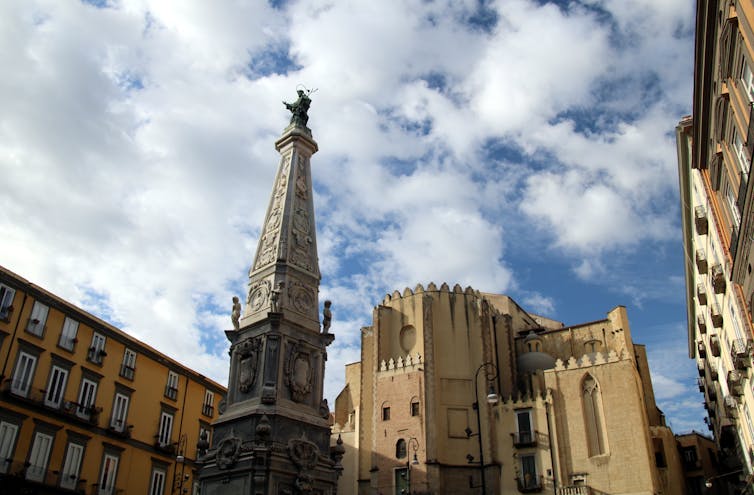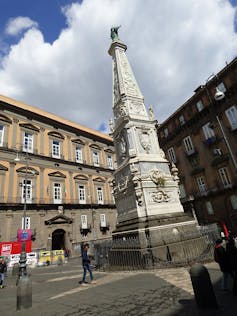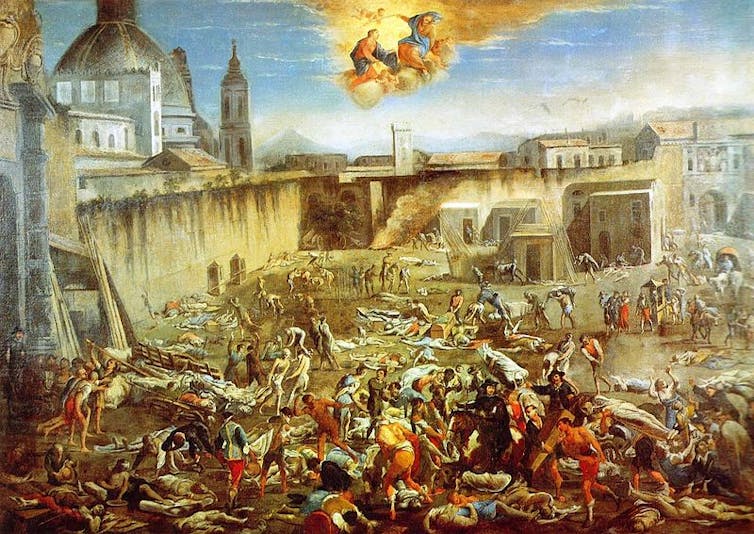Naples memorialized its 17th century plague with a festival for healing, and so should we after COVID-19

A poignant reminder of death stands in Naples, where the old Roman road meets the main college street and the imposing palazzos step back to reveal a sun-drenched plaza.

The spire of San Domenico — a stone obelisk topped with a statue of the saint — is one of Europe’s “plague columns.” Such monuments were erected after devastating epidemics in the 17th century to memorialize the religious figures believed to have interceded to stop the spread of disease.
Vienna still has the most famous one, though others survive. Of the three columns standing in Naples, only the spire of San Domenico was erected to actually commemorate a plague. As art historian Maria Ann Conelli points out, the column shares its form with a type of temporary funeral monument erected to display the coffin of a prominent citizen in baroque-era Italy.
As the one-year anniversary of the World Health Organization’s declaration of a global pandemic approaches (and as vaccination programs begin), it might finally be time to consider how our modern age wants to remember this plague.
End-of-plague festival
Pulitzer-winning art critic Christopher Knight recently suggested we should build a new plague column to remember COVID-19 victims. It’s a brilliant idea. But columns take time. The spire of San Domenico, begun two years after the 1656 epidemic took 79 years to complete.
The Neapolitan civic officials of 1656 have another lesson to teach about how to remember a plague: they put together a grand celebration to mark the containment of the epidemic and help heal a wounded city. For 10 days (instead of the usual eight), beginning on Dec. 1, 1656, the city was transformed by festivities both solemn and joyous.
“After such calamity, and in such a short time,” says a contemporary Jesuit account, the city put together a celebration that was “if not the greatest, as is often said, then at least, no one can deny, one not unequal to those seen in Naples in the midst of its greatest happiness.”
This source, a Jesuit text that celebrated miracles performed during the plague, had reason to put things in the best light. Yet it describes events typical of Neapolitan feasts, for which there are many sources.
Painters, sculptors, musicians, the military, clergy, bureaucrats and politicians all had a role to play. As the procession moved through the streets, people worshipped before spectacular new altars and statues, and listened to musical performances and the thunder of artillery.
“As much a spectacle of beauty as of piety,” the author wrote. “Not a simple tribute, but a full triumph.”
Commissioning artists
The festivities began with a more sombre event on the evening of Dec. 1. The officials responsible for combating the disease, the deputies of health, sat in the cathedral facing a bejeweled statue of Saint Francis Xavier as he was proclaimed protector of the city.
Six months earlier, as the bodies were piling up in the streets, the deputies had prayed to him to intercede and save Naples. On that Saturday in December, the voices of four choirs resounded through the cathedral in a work of thanksgiving, the Te Deum.
“In the number and quality of singers, it was the best of the whole festival,” wrote the author.
Though the religious character of that night might seem striking today, in 1656 all civic officials in Naples professed the Roman Catholic faith and believed it was their duty to ask saints to perform miracles. In June, the Neapolitan city council had in fact commissioned artist Mattia Preti to paint new frescoes depicting saints to be mounted above the city’s gates in order to protect against the plague.
This religious zeal was just one part of a complex civic life — and struggle against an epidemic — with some bracingly familiar features.
There were conspiracy theories about the origins of the virus — that it was “artificially spread to kill the people” as vengeance for an earlier uprising. There was the problem of where to bury the bodies. And there was the heartbreak over shuttered theatres, schools and businesses.
“The whole city had become a tomb,” one observer recalled.

For the city in the shadow of Mount Vesuvius, the December feast must have felt like an eruption of joy. By Sunday night, the solemn religious processions gave way to “the great rejoicing of fireworks and lights.” Neapolitans were so familiar with fireworks displays from past festivals that the account of them simply says that they, “being of the usual sort, don’t need their own particular recounting.”
Social connection, joy
Today, we are all hungry to enjoy the familiar things we did before the pandemic. Neapolitans were too. As a city facing economic, political and religious divisions, Naples celebrated these crucial festivals in order to bring together the city’s disparate parts for a few precious days.
Festivals admittedly served to glorify favoured Catholic saints and strengthen the viceroyalty. But they also put artists to work, fostered social connection and allowed for a brief spasm of joy. Some historians, like John Marino, emphasize the former; others, like Gabriel Guarino, the latter.
When we’re finally ready to get back to normal after COVID-19 will we be content to mark the event with a shopping spree, a haircut and a meal? Or will we take a page from the Neapolitan playbook, updated for our pluralistic world, and come together for a (responsible, socially distanced) feast of music, fellowship and fireworks that could aid social, cultural and economic recovery right now?
Let’s commission spectacular works of music, art and sculpture, as the Neapolitans did, and prepare to revel in eight days of celebration.
If it goes well, we can make it 10.![]()
Keith Johnston, Adjunct Lecturer in History, Algoma University
This article is republished from The Conversation under a Creative Commons license. Read the original article.
